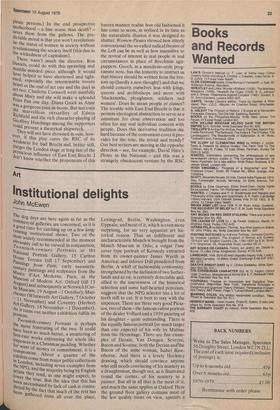Art
Institutional delights
John McEwen The dog days are here again as far as the Commercial galleries are concerned, so it is a good time for catching up on a few longrunning institutional shows. Two of the Most widely recommended at the moment Obviously call to be viewed in conjunction, Twentieth-century Portraits at the N,,ational Portrait Gallery, 15 Carlton House Terrace (till 17 September) and Paintings from Paris, early twentiethcentury paintings and sculptures from the Musee d'Art Moderne, Paris, at the
usetim of Modern Art, Oxford (till 13 `Ingust) and subsequently at Norwich (Castle Museum, 19 August — 1 October); Manchester (Whitworth Art Gallery, 7 October — 11 November) and Coventry (Herbert Art Gallery, 18 November — 1 December). As it turns out neither exhibition fulfils its Promise.
Twentieth-century Portraits is perhaps the more frustrating of the two. It could have been so much better, a smattering of first-rate works enlivening the whole like sixpences in a Christmas pudding. Whether for want of money or commitment, it is a compromise. About a quarter of the exhibits come from major public collections in London, including seven examples from the MPG, and the majority being by English .artists they tend, as one might expect, to lower the tone. But the idea that this has been necessitated by lack of cash is contradicted by the fact that much of the rest has been gathered from all over the place, Leningrad, Berlin, Washington, even Uppsala; andmost of it, which is even more surprising, for no very apparent art historical reason. Thus an indifferent and uncharacteristic Munch is brorught from the Munch Museum in Oslo; a vulgar Time cover type portrait of Kennedy extracted from its owner-painter James Wyeth in America; and inferior Dali plundered from Berlin. A whiff of fashionable conformity, strengthened by the inclusion of two Sutherlands and so on, is certainly detectable and, allied to the unevenness of the historical selection and some half-hearted populism, suggests that the NPG selector has a lot of teeth still to cut. It is best to stay with the sixpences. There are three very good Picassos, two of them — the famous cubist portrait of the dealer Vollard and a 1939 painting of his daughter — quite outstanding. There is the equally famous portrait (so much larger than one expects) of his wife by Matisse from the Hermitage. There are fine examples of Derain, Van Dongen, Severini, Bacon and Soutine, both the Derain andthe Bacon of the same woman, Isabel Rawsthorne. And there is a lovely Hockney drawing, which should convince anyone who still needs convincing of his mastery as a draughtsman, though not, as is illustrated round the corner, of his mastery as a painter. But all in all that is the meat of it, and much the same applies at Oxford. Here the ground floor gallery contains most of the few quality items on view, upstairs a
Soutine is about the only redeeming feature.
In his foreword the Director of the Musee assures us that this selection includes some of his most precious and rare pictures, but looking at all the mannerism on view it is difficult to believe. However, as usual, Matisse and Picasso save the day (many of the artists in both exhibitions look as if they are making the most of the crumbs off their tables), Matisse especially with his early bronze of a 'Woman Lying', one of his key sculptures; and there is a nice corner of high summer fauve work by Braque, Derain and Delaunay.
Great Victorian Pictures at the National Gallery is not an exhaustive survey, as befits what has been a travelling exhibition, but it is academic nonetheless in the breadth of its coverage. There are some familiar favourites — Frith's 'Railway Station', Landseer's 'Stag at Bay', Wallis's 'Death of Chatterton', even Millais's much despised 'Bubbles' — but the weight of the show is taken up with likes of Redgrave, Sadler, Mac Whirter with the likes of Redgrave, Sadler, MacWhirter et al. Names that till recently were consigned to the attic. Clichés and saccharine sentimentality abound, but one or two paintings stand upon their own without the support of Rosemary Treble's thesis, notably Landseer's and two excellent depictions of light, one of the sea by Henry Moore and one of the Highlands by Peter Graham. Significantly all three artists were admired in Paris, and this very painting even won Moore a Legion d'Honneur. The introduction by Rosemary Treble is full of interesting statistics. For instance, over a period of twenty days in 1883 36,000 East Enders went to the Whitechapel Gallery to see this kind of painting and even more daunting, three hundred art critics attended the Press View of the RA in 1892. Plus ga change plus it bloody well is not the meme chose. Last time I went there were six of us.































 Previous page
Previous page